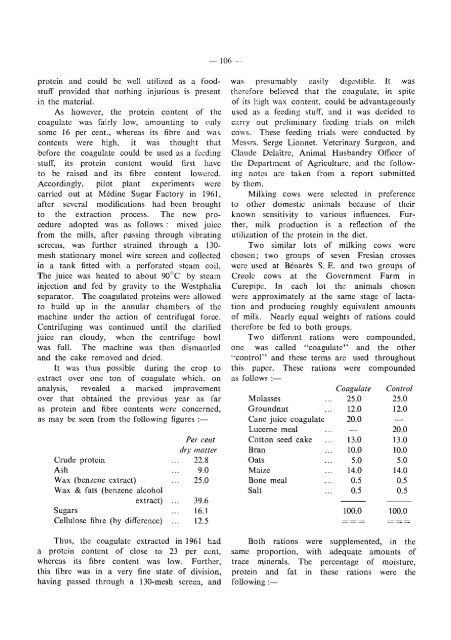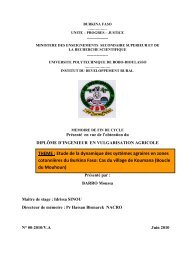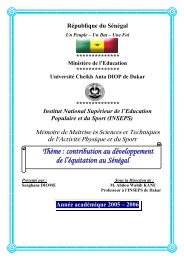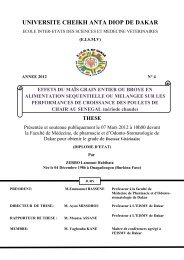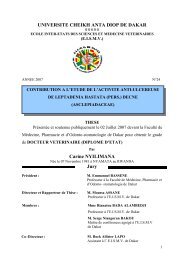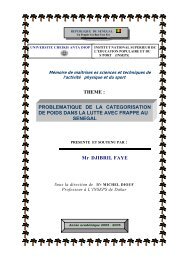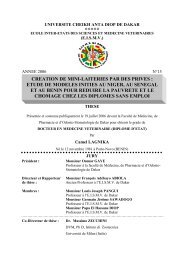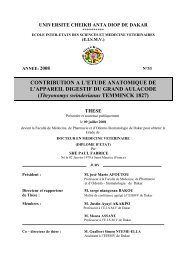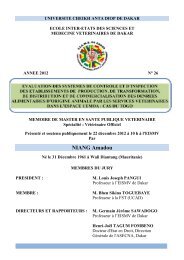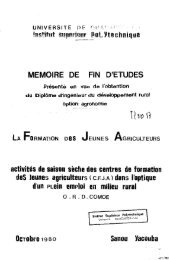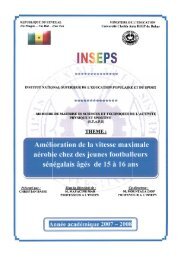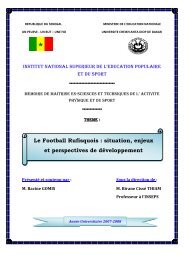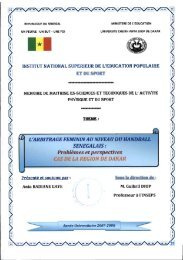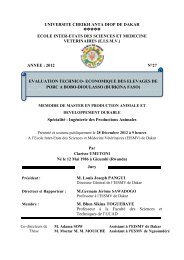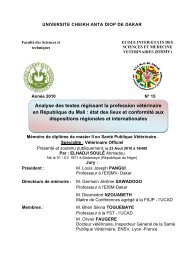-- 106 _.protein and could be well utilized as a foodstuffprovided that nothing injurious is presentin the material.As however, the protein content of thecoagulate was fairly low, amounting to onlysome 16 per cent., whereas its fibre and waxcontents were high, it was thought thatbefore the coagulate could be used as a feedingstuff, its protein content would first haveto be raised and its fibre content lowered.Accordingly, pilot plant experiments werecarried out at Medine Sugar Factory in <strong>1961</strong>,after several modifications had been broughtto the extraction process. The new procedureadopted was as follows: mixed juicefrom the mills, after passing through vibratingscreens, was further strained through a 130mesh stationary monel wire screen and colleetedin a tank fitted with a perforated steam coil.The juice was heated to about 90°C by steaminjection and fed by gravity to the Westphaliaseparator. The coagulated proteins were allowedto build up in the annular chambers of themachine under the action of centrifugal force.Centrifuging was continued until the clarifiedjuice ran cloudy, when the centrifuge bowlwas full. The machine was then dismantledand the cake removed and dried.It was thus possible during the crop toextract over one ton of coagulate which. onanalysis, revealed a marked improvementover that obtained the previous year as faras protein and fibre contents were concerned,as may be seen from the following figures :-Crude proteinAshWax (benzene extraet)Wax & fats (benzene alcoholextract)SugarsCellulose fibre (by difference)Per centdry matter22.89.025.039.616.112.5Thus, the coagulate extracted in 196I hada protein content of close to 23 per cent,whereas its fibre content was low. Further,this fibre was in a very fine state of division,having passed through a l30-mesh screen, andwas presumably easily digestible. It wastherefore believed that the coagulate, in spiteof its high wax content, could be advantageouslyused as a feeding stuff, and it was decided tocarry out preliminary feeding trials on milchcows. These feeding trials were conducted byMessrs. Serge Lionnet. Veterinary Surgeon, andClaude Delaitrc, Animal Husbandry Officer ofthe Department of Agriculture, and the followingnotes are taken from a report submittedby them.Milking cows were selected in preferenceto other domestic animals because of theirknown sensitivity to various influences. Further,milk production is a reflection of theutilization of the protein in the diet.Two similar lots of milking cows werechosen; two groups of seven Fresian crosseswere used at Benares S. E. and two groups ofCreole cows at the Government Farm inCurepipe. In each lot the animals chosenwere approximately at the same stage of lactationand producing roughly equivalent amountsof milk. Nearly equal weights of rations couldtherefore be fed to both groups.Two different rations were compounded,one was called "coagulate" and the other"control" and these terms are used throughoutthis paper. These rations were compoundedas follows :-Coagulate ControlMolasses 25.0 25.0Groundnut 12.0 12.0Cane juice coagulate 20.0Lucerne meal 20.0Cotton seed cake 13.0 13.0Bran 10.0 10.0Oats 5.0 5.0Maize 14.0 14.0Bone meal 0.5 0.5Salt 0.5 0.5100.0 100.0Both rations were supplemented, in thesame proportion, with adequate amounts oftrace minerals. The percentage of moisture,protein and fat in these rations were thefollowing :-
-104-REFERENCESABRAMS, J. T. (<strong>1961</strong>). Animo! Nutrition and VeterinarvDietetics. 'Iv\'. Green & Son, Edinburgh. .BALCH, T. R. (1947). Wax and Fatty Byproducts fromSugar Cane. Tech. Rep. Sug. Res, Fdn. N. Y.,3.BONAME, P. (1897). Ann. Rep. 510. agron. Mauritius,p. 68 -69.BROWN, P. B., RAMON, T. E., d'ESCRIVAIN, T. E.,SINGLETON, C. B., ROBERTSON, e. L. (1959).Sugar Cane Bagasse - Blackstrap MolassesRations with and without Hormones or Antibiotics.Sug. J., 22 (4): 13 - 19.DAVIS, G. K., KIRK, W.K. (1958). Bagasse as aCattle Feed. Sug . J. 21 (4): 13 - 19, 40.DUCKWORTH, r., WOODHAM, AA (<strong>1961</strong>). Leaf ProteinConcentrates. i. Effect of Source of RawMaterial and Method of Drying on Protein Valuefor Chicks & Rats. J. Sei. Food Agrie. 12 : 5 - 15.DUCKWORTH. s., HEPBURN, W.R., WOODHAM,A.A. (<strong>1961</strong>). Leaf Protein Concentrate. ii. TheValue of a Commercially Dried Product. forNewly Weaned Pigs. J. Sri. Food Agric. 12:16 -20.FElLLAFE, S.M. (I96/). Personal Communication.LEITCH, I., GODDEN, W. (1952). Teell. Connnun,Commonw. Bnr.Aniniat Nntr., 14. cited by:Chaycn, l. H., Smith, R. H., Tristram, G. R.,Thirkell, D., and Webb, T. - J. Sei. FoodAgric. <strong>1961</strong>, 12: 503.MAYNARD, L.A., LOOSLl, J.K. (1959). Animal Nutrinon.4th Ed. McGraw - Hill Book Co. Inc.,London.NORMAN. A.G., (1935). The Composition of CrudeFibre. J. Agric Sci. 25: 529 - 540.OWEN, W.L. (1958). Fertilizing Value of CompostingFilter - Cake Muds. Sugar J. 12 (3) : 37 - 43.PARISH, D.H. (I 96Q). Protein from Sugar Cane.Nature, Lond. 188: 601.PARISH, D.H., FIGON, e. ([961). Sugar Cane as aSource of Animal Food. AIII/. Rep. S/!g. Ind.Res. Inst, Mauritius, 1960: 46 - 48.PIRIE, N.W. (19421. Direct Use of leaf Protein inHuman Nutrition. Cliem. & ltnl, 61 : 45.PIRIE, N.W. (l952!. Large-scale Production of EdibleProtein from Fresh LCH\/CS. Ann. Rep. RothamstedExp, Sto. p. 173.PIRIE, N.W. (1960). (a) AIIII. Rep. Rothamstrd Exp. SI".p. 109. (b) Private Communication.PIRIE, N.W. ([961) Private Communication.GEERLlGS, H.e. PRINSEN (1921). Cane Sugar and itsManufacture, Norman Rodgcr, London p, 182.SAINT ANTOlNE, J.D. de R. de, VIGNES, e. (1962).The Extraction of Cane Juice Protein and theAssessment of its value as a Feeding Stuff'. Rev.agrtc. suer. I1e Maurtce 41 (I): 25-30.SAMUELS, G., LANDRAU, P. (1956). Filter-Press cakeas a Fertili/cr. Proc. flit. Congr. Slig. Cane Tech.(India) 9: 119 - 131.STAUB, S.. DARNE, A. (1962). Rapport Preliminaire surI'Utilisaucn des Tourtcaux de Filtrcs-Prcssescorn me . Aliment pour les Anirnaux. Rev.agric. suer, lie Maurice 41 (I) : 31 - 34.DC TOlT, l.L. (<strong>1961</strong>. Filter Cake, Kraal Manure andCompost. S. Africa Sug. J. 45: 979 - 983.TYLER, e. (1950). Animal Nutrition, Chapman &Hall Ltd., London.VIGNES, r.c., de FROBERVILLE, R. (961). ProteinExtraction from Sugar Cane Juice. Anl/.Rep. Sug, Incl. RH. Iust., Mauritius 1960:93 - 97.WIGGINS, L.F. (1960). Sugar and its Industrial Applications.Royal Institute of Chemistry - Lectures,Monographs, <strong>Report</strong>s, 1960, no. 5.2. THE EXTRACTION OFCANEJUICEPROTEINANDTHEASSESSMENT OF ITSVALUEASAFEEDINGSTUFFJ. D. de R. de SAINT ANTOTNE & E. C. VJGNESIn many overpopulated, economicallyunder-developed countries, protein deficiencyposes one of the most acute nutrition problems.With the alarming yearly increase in populationin Mauritius and the island's limited sources ofrevenue, the prospects of an improvement in thesituation arc poor indeed. It is therefore imperativein our case to explore all the avenues
- Page 2 and 3:
MAURITIUS SUGAR INDUSTRYRESEARCHINS
- Page 4 and 5:
SUGAR MANUFACTUREI. The performance
- Page 6 and 7:
STAFFLISTDirectorAgronomistBotanist
- Page 8 and 9:
SPECIALSTUDIES FUNDThe Special Stud
- Page 10 and 11:
INTRODUCTIONTH E act i v it i e s o
- Page 12 and 13:
-11-Zlb"e, ~~J2<
- Page 14 and 15:
-13-M.134/32M.147/44M.31/45M.202/46
- Page 16:
-15-varieties cultivated in Mauriti
- Page 19 and 20:
.. 18··the indications are that i
- Page 21 and 22:
-20is gratifying to find confirmati
- Page 23 and 24:
-~ 22--CANEDISEASESThe main patholo
- Page 25 and 26:
.- 24·-occupying intermediate posi
- Page 27 and 28:
-25-Average 1958-1961 (1960 exclude
- Page 29 and 30:
-27-The first results obtained from
- Page 31 and 32:
-29-have confirmed those obtained l
- Page 33 and 34:
-31-on vanous aspects of sugar manu
- Page 35 and 36:
-33-Some of the more important rece
- Page 37 and 38:
Fig 12. Top . Some of the se lf-sow
- Page 39 and 40:
-36 ---Table 2.Year1956195719581959
- Page 41 and 42:
-38-(ii)Transplantation of seedling
- Page 43 and 44:
-40--The efficiency of selection pr
- Page 45 and 46:
-42--Table 8.Distribution of trials
- Page 47 and 48:
-44-M.253/48 - This variety, derive
- Page 49 and 50:
-46 --The results for the aluminium
- Page 51 and 52:
-48-from moisture stress and leaves
- Page 53 and 54:
- 50A linear relationship was found
- Page 55 and 56:
F ig. 19 Dwarf or multiple bud dise
- Page 57 and 58:
-52-Table 14.Summary of results obt
- Page 59 and 60:
-54-Table 17. Nurseries established
- Page 61 and 62:
Fig . 2] .Perfect stage of the red
- Page 63 and 64: -56-Several methods have been used.
- Page 65 and 66: -58-duties have been defined. The m
- Page 67 and 68: -60-664 flies, all in good state an
- Page 69 and 70: -61-(b)BiologyProgress was made wit
- Page 71 and 72: WEEDCONTROLE. ROCHECOUSTE1. HERBICI
- Page 73 and 74: -65-Table 20.Comparative efficacy o
- Page 75 and 76: CULTIVATION, IRRIGATION, CLIMATE1.
- Page 77 and 78: -69-cos cells at a depth of 6" indi
- Page 79 and 80: -71-It will be observed from the ab
- Page 81 and 82: :rwo.: 40~~a: . J S~X>""-c L JO2 52
- Page 83 and 84: -75-Table 28. Sucrose per cent cane
- Page 85 and 86: -- 77--Table 32. Syrup, massecuites
- Page 87 and 88: -79-A summary of the solids balance
- Page 89 and 90: -81-Non-sugars like silica, starch,
- Page 91 and 92: -83-Table 37.Comparison between Fil
- Page 93 and 94: Fig . 27. Isolates on osrnophilic a
- Page 95 and 96: -85--DOUWES OEKKER (1960) -- Report
- Page 97 and 98: -87-one calculated from the pol rea
- Page 99 and 100: -89~(b). THE DETER!\II\TATlO\T OF R
- Page 101 and 102: -91-The Brix of the cake is obtaine
- Page 103 and 104: -93-(SAINT ANTOINE, 1959) the 1st e
- Page 105 and 106: o..8584,.80"j::I BR E~i~c xn s-95 -
- Page 107 and 108: BY-PRODUCTS1. THE COMPOSITION OF SC
- Page 109 and 110: -99-impossible to obtain a reliable
- Page 111 and 112: -101--Fibre and insoluble carbohydr
- Page 113: -105-of research that could lead to
- Page 117 and 118: -107-MoistureProtein (N x 6.25)Fat
- Page 119: -109-ACKNOWLEDGMENTSExtraction of t


